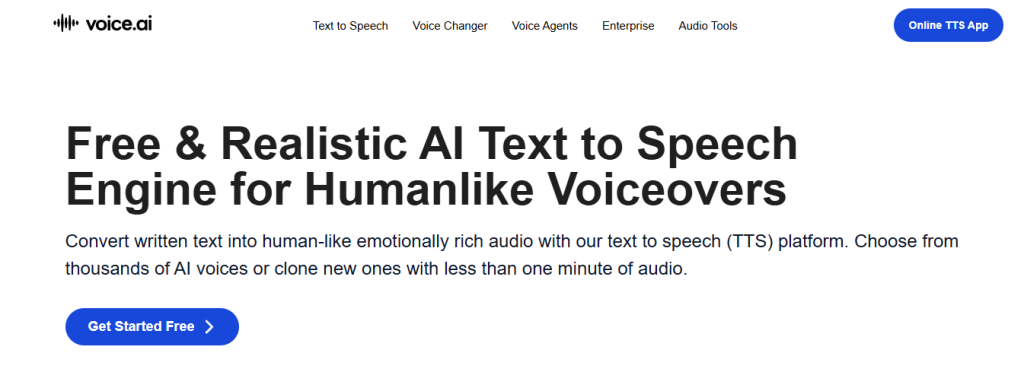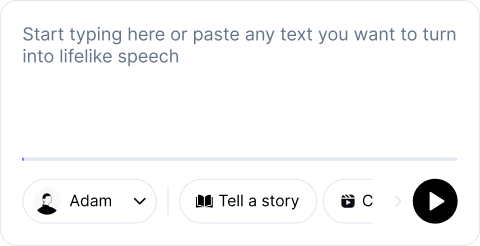Imagine a customer stuck on hold after a late-night transaction, repeating account details to every rep they reach. Conversational AI for Finance pairs chatbots, voice bots, virtual assistants, and natural language processing to automate routine work, route complex cases, flag fraud, and keep interactions personal and compliant. Leading Conversational AI Companies are already driving this change, showing how omnichannel automation, speech recognition, IVR digital banking integrations, conversational analytics, and agent assist can cut costs and lift satisfaction. This article offers practical steps to help you deliver seamless, personalized, and cost-efficient customer experiences in finance through the innovative use of conversational AI.
Voice AI’s text-to-speech tool turns scripts and chat replies into natural-sounding voices for phone, mobile, and web, so you can scale self-service, shorten handle times, and keep every customer touchpoint consistent and personal.
What Are the Specific Use Cases for Conversational AI in Finance?

Modern conversational AI combines natural language processing, machine learning, and generative models to simulate human dialogue with nuance. Add retrieval augmented generation, and the system can pull from your:
- Product rules
- Contract text
- Transaction history
- Up-to-date market feeds
Real-Time Financial Query Resolution
This helps answer specific, grounded questions in real time. That means a virtual assistant can not only say your balance; it can:
- Fetch recent merchant trends on your card
- Surface contract clauses that affect a loan
- Paste a relevant regulation for a compliance question
Gartner believes that in 2025, 85% of customer service leaders will be exploring conversational GenAI, which reflects how teams expect these models to become part of core customer engagement and employee workflows.
Applications Across Financial Sectors: Retail Banking, Wealth, Insurance, Payments, and Enterprise Finance
Retail Banking
Virtual assistants handle balance checks, two-way payments, card activation, dispute intake, and transaction categorization. Examples include:
- Bank of America’s Erica for retail queries
- Commonwealth Bank’s bot that completes hundreds of tasks from transfers to alerts.
Wealth Management
Robo-advisers and digital advisors use chat to:
- Collect goals
- Risk profiling
- Recommend portfolio adjustments or tax harvesting
Firms like Betterment and Wealthfront combine algorithmic advice with conversational front ends.
Insurance
Chatbots speed claims intake by guiding claimants, collecting photos, and triggering automated triage to adjusters. Customers can upload damage photos via chat and get immediate next steps.
Payments and FinTech
Conversational flows enable secure payments, wallet management, and transaction dispute workflows. Payment platforms integrate conversational fraud challenges and instant approvals inside apps.
Enterprise Finance
Treasury and corporate finance teams use chat to query cash positions, forecast liquidity, and request approvals. Internal agents pull from ERP and TMS systems, then summarize exposures for CFOs.
Key Features that Set Conversational AI Apart: Context, Multimodal, and Scale
Context awareness
Systems track session history, customer profile, and recent events so they answer with relevance. If a customer asks about “last week’s charge,” the assistant links intent to the exact transaction.
Multimodal Support
Customers can speak, type, or upload images and documents. A user snaps a cheque image, the assistant reads amounts and suggests deposit steps. Voice recognition and voice biometrics let the system authenticate and route securely.
Real Scalability
Conversational platforms handle millions of sessions without human bottlenecks, enabling 24/7 service and consistent SLAs. When requests need escalation, the handoff includes transcripts, extracted entities, and suggested fixes.
Where Conversational AI Produces Immediate Value: Practical Use Cases that Move the Needle
Smarter Customer Support
AI handles repetitive queries like PIN resets, routing number lookups, or scheduled payment changes. Agents instead handle exceptions and complex negotiations. Systems can reduce average handle time and free human teams to serve higher-value customers.
Improved Fraud Detection
Conversational AI integrates with transaction monitoring engines to surface suspicious transactions and trigger two-way verification. For high-risk items, the assistant sends a secure push or SMS asking for explicit confirmation and can lock cards instantly on confirmed fraud.
Democratizing Financial Advice
Chat-driven robo-advisers onboard users with conversational risk assessment, propose low-cost ETF portfolios, and adjust recommendations as life events appear in transaction data. This expands access to financial planning beyond high-net-worth clients.
Smoother Loan Applications
Customers upload pay stubs and IDs inside chat, receive instant eligibility checks, and see status updates. Bots handle document parsing, KYC, and e-signature handoffs so underwriters see clean, annotated packages.
Employee Enablement
Internal assistants answer compliance queries, surface policy snippets during calls, and accelerate onboarding by teaching teams product details on demand.
AI’s Transformative Role in Financial Services
Conversational assistants build profiles from transaction data, stated goals, and risk tolerance. They use machine learning to identify patterns like rising subscription spend or declining savings rates, then prompt customers with concrete options.
Financial Modeling and Projections
For a customer with falling savings and no investment account, the assistant might ask permission to model a small recurring transfer into a low-cost ETF portfolio, show projected balances, and present tax considerations. On the advisor side, RAG pulls:
- Firm research
- Client holdings
- Market data
This gives advisors quick, evidence-based scripts for client conversations.
Enhancing Customer Experiences: 24/7 Service that Remembers Context and Acts
What if a customer starts a chat about a missed payment and later calls for help? A well-implemented conversational system retains context across channels so the assistant or human agent can pick up without repetition. Bots guide users through:
- App troubleshooting
- Transfers
- Dispute filing
They also send proactive alerts, low balance warnings, rate changes, or tailored product offers, delivered through SMS, app push, or voice depending on the customer’s preference.
Loan, Mortgage, and Claims Assistance: Guiding Customers Through Paperwork and Approvals
Conversational flows break long applications into short, guided steps. Customers supply documents by uploading or taking a photo. The assistant:
- Runs automated eligibility checks
- Extracts key data points
- Flags missing items in real time
For mortgages, the chatbot can calculate loan-to-value, suggest rate-lock windows, and hand off structured files to underwriters. In insurance, chat-based claims intake captures photos, records location, and estimates severity to speed approvals or schedule adjusters.
Transactional and Account Management: Everyday Banking Tasks Without Calls
Most customer contacts are transactional. Conversational AI completes account inquiries, transfers, bill payments, and card controls immediately. It can show projected balances after pending transactions, detect foreign fees, and set travel notices. If a customer asks to activate a card, the assistant:
- Verifies identity
- Performs firewall checks
- Confirms activation within the same session
Exceptional Customer Onboarding: Reduce Friction and Increase Conversion
Onboarding bots guide KYC collection, explain fees, and suggest initial setups like recurring payments. They verify identities with document capture, liveness checks, and cross-referenced data from verification providers. For business customers, the assistant walks through signatory setup and connects to accounting feeds, accelerating time to first transaction.
Strengthening Compliance and Security: Audit Trails, Role Checks, and Secure Verification
Conversational systems log every interaction for regulatory review and can redact sensitive items for archives.
- They risk models in the background.
- They escalate suspicious activity to compliance teams.
- They produce packaged evidence for audits.
Two-way confirmation flows, voice biometrics, and contextual authentication reduce reliance on static passwords while preserving proof of consent and disclosure.
Agent Assistance: How AI Primes Humans to Resolve Harder Cases
Agent assist tools summarize customer intent, surface relevant policies, and suggest answers while the agent types. Real-time analytics highlight:
- Critical words
- Compliance triggers
- Recommended next steps
That reduces average handle time and training needs, and improves first contact resolution by giving agents the proper knowledge at the right moment.
Concrete Examples and Architecture Patterns: Tying Tech to Business Outcomes
Retrieval augmented generation powers explanations grounded in your documents. Imagine a customer asks, “Can I prepay my mortgage without penalty?” The assistant retrieves the loan contract clause, cites the exact language, and offers the next steps for payoff. In fraud scenarios, anomaly detection flags a charge.
Automated Fraud and Workflow Management
The assistant asks a confirmation question through secure push, and if unconfirmed, freezes the card and opens a claim with all contextual data prefilled for an investigator. Enterprise finance teams use conversational queries against ERP and cash management systems to get instant cash positions, then request approvals that feed into workflow engines.
Security, Privacy, and Regulatory Controls You Must Build In
Implement strict role-based access control for personal and account data—Encrypt data in transit and at rest. Use auditable consent hooks before any action that moves money. Keep model outputs grounded by limiting generative replies unless a RAG chain-of-custody confirms source documents.
Archive interactions with tools that meet regulatory retention standards and integrate with compliance systems for supervision and eDiscovery.
What to Measure and How to Run Pilots
Track containment rate, average handle time, conversion lifts for offers, and false favorable rates for fraud verification. Monitor CSAT by channel and the impact of agent augmentation on shrinkage and training costs. Start with narrow use cases such as:
- Balance inquiries
- Card controls
- A single loan product
Prove accuracy and compliance at a small scale, then expand into wealth, claims, and enterprise workflows while maintaining rigorous testing and human oversight.
Questions for Your Team: To Surface Gaps Before You Build
- Which customer journeys generate the most repetitive work?
- How will you verify identity across channels?
- What sources will your RAG layer index, and how will you maintain that knowledge base?
- Which compliance rules require documented consent or special handling?
Answering these helps prioritize use cases that reduce cost and raise satisfaction without adding risk.
Related Reading
- Conversational AI Examples
- AI for Customer Service
- How to Create an AI Agent
- Conversational AI in Healthcare
- Conversational AI for Customer Service
- AI for Real Estate Agents
- AI for Insurance Agents
- How to Use AI in Sales
- AI in Hospitality Industry
What Are the Benefits of a Conversational AI Solution for Finance?

Conversational AI delivers fast, contextual responses through chatbots, voice assistants, and in-app messaging. Customers get personalized guidance on accounts, payments, and products while sentiment analysis and intent recognition adapt replies to tone and need. For retail and wealth clients, this means:
- Fewer clicks
- Clearer offers
- Better impression of the bank as helpful and modern
Cut Costs, Not Quality: Cost Efficiency
AI automates repetitive inquiries and routine transactions, shifting volume away from contact centers and lowering headcount pressure. Virtual agents manage:
- Password resets
- Balance checks
- Simple payments
Live agents handle disputes and sales. That model reduces operating expense and improves cost per interaction without degrading service quality.
Handle Any Surge: Scalability at Scale
When markets move or tax season hits, AI scales to meet peaks across channels. Cloud-based models and load balancing let institutions handle hundreds of thousands of concurrent chats and voice sessions. Banks keep service-level goals during spikes and avoid long queues that erode trust.
Turn Conversations into Insights: Data Collection and Analysis
Every dialogue becomes structured data for intent, product interest, and friction points. Natural language understanding and conversation analytics extract:
- Trends
- Common complaints
- Upsell signals
Teams use that insight to tune product offers, optimize funnels, and measure customer journey improvements.
Smarter Fraud Defense: Increased Security and Fraud Prevention
Machine learning models running in real time detect anomalies in transaction patterns and conversational behavior. Voice biometrics, behavioral profiling, and adaptive authentication reduce false positives and speed legitimate access. Instant alerts from a chatbot let customers:
- Lock cards
- Reset credentials
- Confirm suspicious charges without waiting for a phone agent
Always On Support: Customer Service and 24/7 Availability
Conversational agents are available around the clock across web, mobile, SMS, and voice. Customers get on-demand answers outside business hours, and handoffs to human specialists preserve conversation context using unified conversation histories. That continuity raises satisfaction and reduces repeat contacts.
Find and Nurture Leads Automatically: Generating New Leads
Chatbots identify interest signals, qualify leads with targeted questions, and route high-value prospects to sales teams. Conversational forms and guided flows reduce friction for product signups and demo requests. This approach:
- Increases conversion rates on digital channels
- Shortens the time to first contact
Apply for Products Without a Branch Visit: Applying for Services
Integrated conversational flows can prefill applications, simulate loan offers, and collect digital signatures. Bots combine KYC checks, eligibility rules, and document uploads so customers can complete new accounts or credit requests in one session. That reduces drop-off and speeds time to funding.
Detect and Act on Suspicious Activity: Monitoring for Suspicious Activity
Chatbots monitor account activity and surface anomalies to both compliance teams and customers. When a model flags unusual transfers or login attempts, the assistant:
- Prompts account verification
- Locks access
- Escalates to fraud analysts
The combination of automated detection and immediate customer action tightens risk controls.
Quick Access to Money Info: Checking Balances and Transactions
Users can request balances, recent transactions, scheduled payments, or card status via voice or text. Bots push threshold alerts and custom notifications so customers act before fees or overdrafts occur. These quick interactions cut app navigation friction and raise engagement.
Boost Revenue with Smarter Conversations: Increased Revenue
AI increases customer lifetime value by enabling contextual upsells and targeted offers at the right moment. Personalized campaigns driven by conversation signals improve:
- Cross-sell
- Retention
Subscription-style services, proactive advice, and actionable nudges convert engagement into measurable revenue gains.
Let Staff Do Higher Value Work: Improved Team Productivity
With bots handling routine items, human teams focus on complex service, relationship management, and sales. AI also automates back office tasks: case summaries, form distribution, and follow-up reminders. That raises average handle quality and saves agent time.
Rich Customer Profiles from Conversations: Collecting Rich Customer Data Insights
Conversation logs feed unified customer profiles that combine sentiment, intent, and product preferences. Analytics and cohort segmentation reveal churn risk, product affinity, and channel preferences for targeted retention programs. These profiles power personalization across CRM, marketing automation, and wealth platforms.
Compare, Compete, and Close Gaps: Enhancing Competitive Benchmarking
Conversation analytics reveal where competitors outpace you on speed, response quality, or available channels. Benchmarking against industry metrics informs feature roadmaps and channel investment. That keeps product teams focused on improvements that move KPIs.
Lower Costs, Better Outcomes: Lower Operating Costs
Self-service flows, secure links, and two-factor notifications cut waste and prevent avoidable incidents. Automation trims repetitive tasks and reduces time to resolution, lowering cost per ticket and supporting margin growth. The savings fund product innovation and reinvestment in customer trust.
How this Aligns with Bank Goals: Trust, Retention, Profitability
Conversational AI increases transparency through clear, auditable interactions and faster fraud response. It raises retention by improving experience and personalization, and it boosts profitability by lowering service costs and increasing conversions. What matters to executives is measurable impact on CLV, NPS, and cost to serve, all of which conversational AI helps improve.
Want to try high-quality voice quickly? Stop spending hours on voiceovers or settling for robotic-sounding narration. Voice.ai’s text-to-speech tool delivers natural, human-like voices that capture emotion and personality.
Related Reading
- Conversational AI for Sales
- AI Sales Agents
- Conversational AI in Retail
- Conversational AI in Insurance
- Conversational AI in Banking
- Voice Ordering for Restaurants
- Conversational AI IVR
- Conversational AI for Banking
- Conversational AI Design
- Conversational AI Ecommerce
How to Implement Conversational AI in Finance

Pick High Return Use Cases: Start Small, Win Fast
Choose repeatable tasks that waste time today. Missed payment reminders, onboarding steps that drop out, balance checks, and password resets are clear examples. Ask this: which routine exchanges take agents away from complex work? Begin with one channel people already use, like SMS or secure chat, and automate simple flows first. Prove value, then expand to:
- Voice
- Mobile app messaging
- Omnichannel support
Step by Step Roadmap: From Pilot to Production
1. Define scope and success metrics
Pick one use case, list KPIs such as resolution time, deflection rate, and escalation rate, and set target thresholds.
2. Align stakeholders
Get sign-off from compliance, security, product, operations, and contact center leaders. Who owns the service level agreements and audit requirements?
3. Map data and integrations
Inventory CRM records, transaction systems, identity stores, and notification platforms. Identify APIs and data flows you must access.
4. Design compliance and security controls
Specify encryption, retention, identity verification steps, and logging before you build.
5. Select a platform that supports CRM and API integration, messaging channels, and role-based access
Confirm non-developers can update it.
6. Build an MVP conversation flow and NLU model using real transcripts
Include fallback, escalation, and error handling.
7. Run a closed pilot with a slice of users
Collect conversation logs, agent feedback, and quantitative metrics.
8. Iterate on NLU models, dialog branches, and handoff triggers
Retrain with corrected labels and new examples.
9. Deploy to production in measured phases and keep visibility into each channel.
10. Maintain a governance cadence for reviews, model updates, and compliance audits every quarter or on regulatory change.
Design for Compliance: Audit Trails, Retention, and Identity
Finance requires clear accountability. Encrypt data in transit and at rest. Log every message with timestamps, user IDs, and system actions so conversations are ready for:
- FINRA review
- GLBA review
- GDPR review
Enhanced Security and Compliance
Implement identity verification flows such as mobile PINs, two-factor authentication, and secure fallbacks for high-risk actions. Define retention policies that meet regulatory obligations and automate archival to your records system. Apply role-based access so teams see only what they need to do their job.
Pick Technology That Fits Your Stack: Integrations That Matter
- Pick a platform that plugs into your CRM, payment systems, account ledgers, and notification services.
- Confirm the conversational engine can pull authorizations and transaction context in real time and route messages through your existing communications provider.
- Look for orchestration, API connectors, and admin tools that let ops change flows without code.
- Require dashboards for observability so you can watch intent detection accuracy, handoff timing, and channel performance.
Train the Model and the Team: Real Transcripts, Good Design, Smooth Handoffs
- Use historical call and chat transcripts to train intent classification, entity extraction, and dialog management.
- Tag standard failure modes and build branches that guide users back on track.
- Train staff on where the AI takes over and where human escalation kicks in.
- Create playbooks for agents: how to view conversation history, how to correct NLU mistakes, and how to add training examples.
- Test handoffs so context flows with the conversation and the agent can step in without asking repeated questions.
Measure What Moves the Needle: KPIs for ROI and Risk
- Track operational KPIs and risk signals together. Include average resolution time, first contact resolution, deflection rate, repeat contact frequency, escalation ratio, and percent of interactions routed incorrectly.
- Monitor user drop-out points, time to handoff, and rate of sensitive data exposure.
- Add model health metrics such as intent accuracy, entity extraction precision, and data drift. Pair these with business KPIs: cost per case, agent utilization, and customer satisfaction.
Continuous Monitoring, Feedback Loops, and Iterative Improvements
- Set up automated monitoring for model drift, error spikes, and unusual conversation patterns.
- Capture agent corrections and customer feedback as labeled training data and feed that back into regular retraining cycles.
- Run A/B tests on dialog variants and measure the change in resolution and escalation.
- Schedule short iteration cycles: weekly reviews for urgent fixes, monthly model retrains, and quarterly governance checks. Keep feedback loops tight so the system learns from fundamental interactions and operations can respond fast.
Operational Rules: Security, Privacy, and Change Management
- Create a vendor risk checklist and require third-party audits when you use external models or services.
- Enforce least privilege access, strong encryption, and secure development practices.
- Build an incident response plan that covers data leakage, fraud attempts, and model failures. Version control flows and policies so every change is auditable and reversible.
- Set release gates that require compliance sign-off before new flows go live.
Clerk Chat in Practice: What Comes Ready and What You Still Need to Do
Clerk Chat provides archiving integrations, role-based permissions, and tools for branching flows without plugins. It supports SMS first pilots and easy updates to dialog trees so teams can make changes quickly. You still need to:
- Map your specific integrations
- Define identity verification rules
- Align retention policies with regulators
Use Clerk Chat to reduce developer overhead while you build integration points and governance around production data.
Operationalizing Security and Fraud Controls in Conversations
Add fraud detection signals into conversations:
- Unusual transaction patterns
- Device anomalies
- Rapid authentication failures
Security and Fraud Mitigation
Let the conversational agent flag or pause high-risk actions and route to a specialized fraud team. Keep logging granularly so you can reconstruct events for investigations and regulatory review. Apply data minimization in dialogs so sensitive values are redacted and stored only where allowed.
Upgrade Training Data and Governance: Labeling, Review, and Retraining
- Create a labeling pipeline that captures edge cases, ambiguous intents, and new products. Use human reviews to approve labels and feed them into supervised retraining.
- Monitor model performance by cohort so you spot problems by product, channel, or customer segment.
- Set up approval workflows for retraining and model deployment that include compliance and business owners.
Where Conversational AI for Finance Is Heading: Agents, Copilots, and Smarter Personalization
Agentic AI will enable bots that plan and act on tasks such as resolving a bounced payment or proposing a payment plan. Internal copilots will assist agents by:
- Surfacing account history
- Summarizing conversations
- Applying regulatory language in real time
Personalization will use transaction patterns and product usage to tailor suggestions and proactive outreach. Systems will build compliance checks into the dialog so transcripts are ready for audit, and suspicious activity is flagged automatically.
Practical Questions to Ask Before You Buy or Build
Do you have transcripts and labeled examples to train models today? Can the platform connect to your primary ledger and CRM via API? How does the vendor handle encryption, retention, and audit exports? What controls exist for human handoff and agent override? Who owns the model governance and retraining schedule within your org?
Quick Risk Checklist You Can Use in a Sprint
Confirm encryption in transit and at rest. Validate identity verification for sensitive flows. Enforce role-based access. Log every action with context. Schedule model health checks and audit reviews. Make sure these items are part of your first pilot and governance board agenda.
Implementation Timing and Resource Planning
Expect a multi-month cadence for a secure production rollout. A focused pilot can run in six to eight weeks if you have transcripts and clear integrations. Allocate resources for:
- Compliance review
- API work
- Conversation design
- Model training
Plan ongoing headcount for operations, analytics, and governance so that monitoring and iterative improvement happen continuously. How will you staff those responsibilities in the next quarter?
How Can You Measure the Success of a Conversational AI Solution in Finance?

First Call Resolution measures the share of customer issues solved during the first interaction across voice, chat, and digital channels. Calculate FCR as resolved contacts on the first contact divided by total contacts, and track it by:
- Channel
- Intent
- Product line
- Agent cohort
Enhancing First Contact Resolution (FCR)
Use call and chat logs, transcript intent labels from natural language understanding, and post-interaction surveys to validate whether customers consider the issue resolved. Expect up to an 80 percent uplift in FCR when financial firms move from manual routing and script-driven support to conversational AI with:
- Intent recognition
- Automated verification
- Context retention
To keep FCR accurate, exclude transfers that are planned steps in a flow, capture callbacks within a defined window, and reconcile agent notes with NLU resolution tags so you measure absolute containment.
Cut OpEx with Automation: Measure the Money Saved
Operational expenditure reduction quantifies cost savings from:
- Automation
- Workforce efficiency
- Channel deflection
Build a baseline using cost per contact, full-time equivalent counts, vendor costs, and technology spend before conversational AI deployment. Then compute OpEx reduction as baseline OpEx minus post-deployment OpEx divided by baseline OpEx, and annualize the savings.
Operational Cost Reduction
Across multiple implementations, a 70 percent OpEx reduction has been observed by organizations adopting enterprise conversational AI solutions that combine voice bots, chatbots, IVR automation, and CRM integration. Attribution requires careful accounting for:
- One-time implementation costs
- License fees
- Any shifted costs to cloud or DevOps
This enables finance and operations to agree on net recurring savings.
Average Handle Time: Shorten Interactions and Preserve Quality
Average Handle Time equals total talk time plus hold time plus after-call work divided by the number of handled contacts. Conversational AI reduces AHT by:
- Automating identity checks
- Auto-filling forms
- Surfacing knowledge base answers
- Providing agent assist prompts
Reducing Average Handle Time (AHT)
Measure AHT per intent and channel, and compare agent-assisted versus fully automated sessions. Expect around a 60 percent reduction in AHT where automation covers repetitive tasks and agent assist speeds complex decision-making. Monitor the tail of the AHT distribution to catch complex cases that require escalation and to refine handoff rules.
Hold Time: Get Customers Off Hold Faster
Hold time measures how long customers wait before an agent actively engages. Use IVR and contact center timestamps to:
- Compute average hold and median hold
- Segment by time of day and queue
Minimizing Customer Hold Times
Conversational AI reduces hold time by triaging routine requests to a virtual assistant, enabling intelligent routing based on intent and customer profile, and automating verification before agent handoff. Clients typically see about a 30 percent decrease in hold time when virtual assistants handle verification and routing workflows. Track hold time alongside abandonment rates to:
- Understand customer tolerance
- Optimize queue thresholds
Customer Experience CSAT: Measure Satisfaction, Not Just Speed
CSAT captures how satisfied customers are with a specific interaction, usually via a post-interaction micro survey. Deliver surveys across channels and pair CSAT with sentiment analysis from transcripts and voice analytics to get both explicit and implicit signals.
Conversational AI drives personalization, faster resolutions, and consistent answers, producing reported CSAT gains of nearly 30 percent in many deployments. Segment CSAT by intent, cohort, and channel so you can link experience improvements to specific AI features like:
- Personalized routing
- Context retention
- Cross-sell accuracy
Agent Performance: Make Agents More Effective with an AI Co-Pilot
Agent performance covers resolution rates, adherence to scripts, quality scores from QA, average handles, and conversion or cross-sell success where applicable. Implement agent assist to provide:
- Suggested replies
- Knowledge snippets
- Policy checks
- Compliance prompts
Boosting Agent Productivity
These measures determine whether these interventions reduce error rates and speed decisions. Expect around a 20 percent lift in agent productivity when conversational AI:
- Supplies real-time guidance
- Automates routine steps
- Reduces cognitive load
Use calibrated QA scoring and longitudinal dashboards to turn raw performance data into coaching actions.
Evaluation Methods: Prove the Value with Rigorous Experiments and Analytics
Use randomized controlled rollouts, A/B testing, and phased pilots to isolate the impact of conversational AI versus business as usual. Define primary KPIs before launch, set minimum detectable effect sizes, and choose appropriate sample sizes and test durations. Combine quantitative measures with qualitative review:
- Transcript audits
- Mystery shopping
- Agent focus groups
Improving AI Performance and Accuracy
Include conversational analytics that surface:
- Intent accuracy
- False positive and false negative rates
- Turn-taking patterns
- Dialogue completion rates
Keep statistical significance thresholds and monitor model drift, retraining NLU models on new utterances, to maintain high accuracy.
Align Metrics with Strategic Goals: Map KPIs to Business Priorities
Tie every metric to a strategic objective such as customer retention, cost reduction, digital transformation, regulatory compliance, or revenue growth. For example:
- Map FCR and CSAT to retention and wallet share.
- Map OpEx and AHT to operating margin.
- Map agent performance to capacity planning and frontline morale.
Create a benefits ledger that translates metric changes into dollars and customer lifetime value impact so executives can prioritize use cases that yield the best return. Use a change of control groups to make the business case visible to finance and risk teams.
Operational Signals and Data Sources: Where the Evidence Lives
Pull signals from contact center logs, IVR records, speech-to-text transcripts, chat histories, CRM and core banking APIs, knowledge base analytics, workforce management systems, and cost ledgers. Enrich logs with NLU labels such as:
- Intent
- Entity extraction
- Sentiment
- Confidence scores
Ensure data governance, privacy, and audit trails meet compliance and KYC requirements while enabling reproducible measurement. Assign data stewards and produce a single source of truth for dashboards so teams trust the numbers.
Reporting Playbook: Targets, Cadence, and Dashboards that Move Teams
Set short-term and medium-term targets, for example, three-month and twelve-month checkpoints, using the expected improvements as reference points. Report daily operational metrics for alerts, weekly trends for ops teams, and monthly executive summaries that translate KPIs into:
- Spend impact
- Customer value
Build dashboards that let you drill from OpEx numbers down to individual intents, with alerts for falling NLU accuracy, rising false containment, or unexpected escalation patterns so product, ops, and finance act on the same set of signals.
Try Our Text-to-Speech Tool for Free Today

Cut recording sessions, retakes, and manual editing from your workflow. Voice AI automates batch production, version control, and quick edits, enabling you to move from script to audio in minutes rather than hours.
Use built-in controls for pacing, emphasis, and pauses to match your brand voice without forcing extra studio time. What would you do with the additional hours saved on each project?
Human-Like Voices That Capture Emotion and Personality
Our text-to-speech system models prosody, tone, and subtle inflection so narration sounds human-like and expressive. You can choose softer, authoritative, friendly, or urgent delivery to match the message, while retaining clarity for speech recognition and conversational agents. That makes the helpful output not only for podcasts and eLearning, but for:
- Voice banking prompts
- IVR messages
- Agent assist scripts that must convey trust
Designed for Content Creators, Developers, and Educators Who Need Professional Audio Fast
Creators get ready to publish audio that matches their vision. Developers get APIs and SDKs to integrate voice capabilities into apps, chatbots, and contact center automation. Educators get accessible narration in multiple languages for courses and training. How do you want to deploy audio—inline with a chatbot, in a mobile app, or as narrated video content?
Choose from a Rich Voice Library and Generate Speech in Multiple Languages
Pick from a catalog of voice personas and regional accents, toggle style and emotion, and export in standard codecs for easy editing. Multilingual support includes regional variants so you can serve customers and learners in the language they prefer. Use language-specific pronunciations to improve intent detection and reduce friction in speech-to-text workflows for multilingual conversational AI.
Transform Your Projects with Voiceovers That Sound Real
High fidelity synthesis, noise reduction, and audio normalization produce clean voiceovers ready for publication. The voices integrate with captioning, timing markers, and editing tools so you can match audio to on-screen visuals and dialogue management systems.
Will your next video, tutorial, or IVR script sound like it was made in a studio or assembled in a rush?
Try Voice AI for Free Today and Hear the Difference
Sign up, test sample voices, and access an API key to generate speech immediately. The free tier lets you evaluate quality, latency, and multilingual handling before scaling. Need enterprise-grade throughput or custom voice development? Contact the team to discuss:
- Usage-based plans
- On-premises options
- Custom voice licensing
How Voice AI Strengthens Conversational AI for Finance Use Cases
Use TTS for voice banking, balance notifications, payment confirmations, and fraud alerts that read naturally. Combine text-to-speech with speech-to-text, natural language understanding, and intent classification to build virtual assistants that:
- Handle inquiries
- Route calls
- Complete transactions
Add sentiment analysis and conversational analytics to detect upset customers, trigger agent handoff, and reduce average handle time in contact center automation.
Security, Compliance, and Authentication for Financial Services
Encrypt audio in transit and at rest, implement role-based access, and log every API call for audit trails. Use voice biometrics for secure authentication paired with multi-factor methods and KYC checks to reduce fraud. Support data residency and retention controls to help meet regulatory needs for AML checks and reporting requirements.
Integration and Developer Tools That Move Fast
API endpoints support streaming and batch generation, with SDKs for web, mobile, and server environments. Pair TTS with dialogue management and agent assist to surface:
- Transaction history
- Confirm amounts
- Read policy disclosures in context
Do you want a hands-on demo or sample code to test integration with your IVR or chatbot?
Analytics and Continuous Improvement
Track usage, identify fallback intents, and run A/B tests on voice personas to see which tones:
- Improve conversion
- Reduce churn
- Speed task completion
Export conversational analytics to improve dialog flows, refine intent detection, and optimize prompts for compliance and customer satisfaction. Which metric matters most for your team—engagement, containment, or conversion?
Related Reading
- Examples of Conversational AI
- Conversational AI for Finance
- Conversational AI Cold Calling
- Air AI Pricing
- Conversational AI Analytics
- Conversational AI Tools
- Conversational AI Hospitality
- Conversational Agents
- Voice AI Companies





